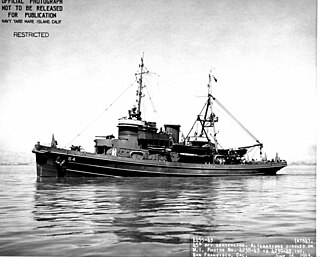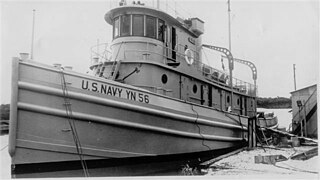
USS Algonquin, completed as El Toro in 1891 for the Southern Pacific Railroad's Morgan Line, was a small harbor tug commissioned by the United States Navy 2 April 1898. Renamed Accomac, after Accomac, Virginia, June 1898, renamed Nottoway in 1918 and, after the Navy adopted alphanumeric hull numbers on 17 July 1920, classified as YT-18, a district tug. On 5 October 1942 the name was cancelled and the tug was simply YT-18 until 1944 when classification was changed to YTL-18, a little harbor tug. Over the years as a Navy tug, from 1898 to 1946, the tug served from Cuba to Boston.
USS Namontack (YN-46/YNT-14/YTB-738) was built in 1938 as the Thomas E. Moran by the Defoe Shipbuilding Company, Bay City, Michigan, for the Moran Towing and Transportation Company, New York City. The name "Namontack" comes from a Native American sent, in 1605, by Chief Powhatan to live with English settlers in Tidewater, Virginia, and gain knowledge of their customs and language. Christopher Newport took him to England on 10 April 1608 to meet the Virginia Company's investors. Namontack remained there for three months and returned to Virginia.

USS Navajo (AT-64) was an oceangoing tugboat in the United States Navy, and the lead ship of its class. It was named for the Navajo people. Originally called the Navajo-class of fleet tugs, it was later renamed the Cherokee-class after loss of the first two ships of the class.
USS Bomazeen was originally the Bathgate, a tugboat built in 1919 at New York and purchased by the United States Navy on 29 December 1941 from the Meseck Towing Lines. She was renamed Bomazeen; designated YT 238 and placed in service on 4 February 1942.
USS Alloway (YT-170/YTM-170) was an Alloway-class tugboat acquired by the U.S. Navy for the task of providing yard tugboat services during World War II, when U.S. ports were often congested with ships arriving and departing.

A net laying ship, also known as a net layer, net tender, gate ship or boom defence vessel was a type of naval auxiliary ship.

USS Koka (ATA-185) was a US Navy tugboat. Koka is from the phonetic spelling of Coca, formerly an Indian village in southern Arizona. Originally designated as ATR-112, she was redesignated as ATA-185 on 15 May 1944; launched 11 September 1944, by Levingston Shipbuilding Co., Orange, Texas; and commissioned on 16 November.

USS Penobscot (SP-982/YT-42/YTB-42) was a commercial harbor tugboat purchased by the U.S. Navy at the start of World War I. Penobscot performed her towing services for the 5th Naval District on the U.S. East Coast, and continued to do so for the 3rd Naval District through the end of World War II. She was finally retired from Navy service in 1947.

USS Favorite (SP-1385/ID-1385/IX-45) was a large 1223 gross ton tugboat acquired by the U.S. Navy during World War I. She performed a variety of work for the Navy, including icebreaking, salvage, wrecking, and tugboat services. She was loaned to Panamanian authorities after World War I, but was returned to the U.S. Navy to do her part in the Panama Canal area during World War II as the IX-45.
USS Corkwood (AN-44/YN-63) was an Ailanthus-class net laying ship which served with the U.S. Navy in the western Pacific Ocean theatre of operations during World War II. Her career was without major incident, and she returned home safely after the war with one battle star to her credit.

The first USS Wandank (AT-26), originally Fleet Tug No. 26, later ATO-26, was a United States Navy fleet tug in commission from 1920 to 1922 and again from 1922 to 1946.

USS Wapasha (YN-45), later YNT-13, later YTB-737, was a United States Navy net tender, later large harbor tug, in commission from 1941 to 1947.

USS Wapello (YN-56), later YNT-24, was a United States Navy net tender in commission from 1941 to 1946.
USS Sotoyomo (ATR-43/ATA-121) was a rescue tug of the United States Navy that served during World War II and the early 1950s, and was sold to Mexico in 1963.
HMAS St Giles (FY86) was a tugboat which was operated by the Royal Navy (RN), Royal Australian Navy (RAN) and the Australian shipping firms J. & A. Brown and the Waratah Tug and Salvage Company. She was built by Ferguson Shipbuilders, Glasgow for the RN in 1919, was sold to J. & A. Brown in 1925, transferred to the Waratah Tug and Salvage Co Pty Ltd in 1931 and was commissioned into the RAN between 1940 and 1942 and 1945 and 1946 before being scrapped in 1956.
Modoc was a steam tug, built in 1890 as the commercial tug Enterprise, in service with the United States Navy from 1898 to 1947. The tug had been assigned the hull number YT‑16 in 1920. When the name Modoc was cancelled 5 October 1942 the tug became the unnamed YT‑16 until reclassified in 1944 to become YTL-16. The tug served for 49 years and in both World War I and World War II before being transferred to the Maritime Commission in early 1947 for disposal.

The Type V ship is a United States Maritime Commission (MARCOM) designation for World War II tugboats. Type V was used in World War II, Korean War, and the Vietnam War. Type V ships were used to move ships and barges. Type V tugboats were made of either steel or wood hulls. There were four types of tugboats ordered for World War II. The largest type V design was the sea worthy 186-foot (57 m) long steel hull, V4-M-A1. The V4-M-A1 design was used by a number of manufacturers; a total of 49 were built. A smaller steel hull tugboat was the 94-foot (29 m) V2-ME-A1; 26 were built. The largest wooden hull was the 148-foot (45 m) V3-S-AH2, of which 14 were built. The smaller wooden hull was the 58-foot (18 m) V2-M-AL1, which 35 were built. Most V2-M-AL1 tugboats were sent to the United Kingdom for the war efforts under the lend-lease act. The Type V tugs served across the globe during World War II including: Pacific War, European theatre, and in the United States. SS Farallon, and other Type V tugs, were used to help built Normandy ports, including Mulberry harbour, on D-Day, 6 June 1944, and made nine round trips to Normandy to deliver Phoenix breakwaters.
Everett-Pacific Shipbuilding & Dry Dock Company was established in 1942 to build ships needed for World War II. Yard construction began on 1 March 1942. As part of the Emergency Shipbuilding Program the US Navy provided some of the capital to start Everett-Pacific Shipbuilding at Port Gardner Bay in Everett, Washington. Everett-Pacific was sold in 1945 to the Pacific Car and Foundry, who was already a major manufacturer of railcars and trucks. Pacific Car and Foundry was building barges for the US Navy during World War II at plants in Renton, Seattle and Tacoma in the state of Washington. The lease for the shipyard in Everett, Washington ended in 1949 and the yard closed. Pacific Car and Foundry in 1972 changed its name to Paccar Inc. to reflect its major products. The Everett-Pacific shipyard site later became part of Western Gear, a heavy machinery manufacturer. in 1987 the shipyard became part of Naval Station Everett. Everett-Pacific Shipbuilding was started by William Pigott Jr. a Seattle businessmen and his brother Paul Pigott (1900-1961). William Pigott Jr. was born in 26 Aug. 1895 in Pueblo, CO and died on 8 July 1947 in San Francisco, CA.

USS Mosopelea (ATF-158) was Abnaki-class tugboat during the World War II and Cold War. Her namesake is an Indian tribe which inhabited the area near the junction of the Ohio and Mississippi Rivers.










